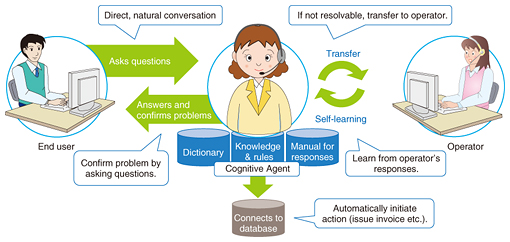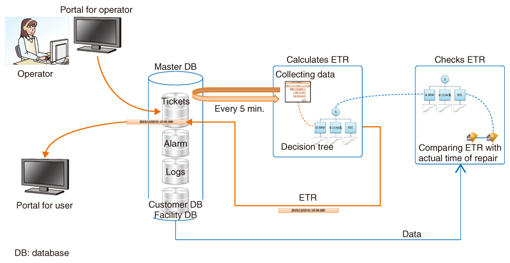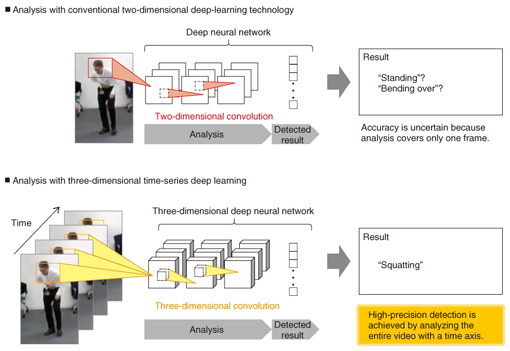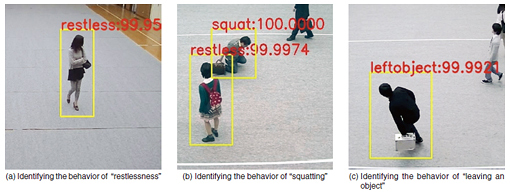 |
|||||||||||
|
|
|||||||||||
|
Feature Articles: Artificial Intelligence Research Activities in NTT Group Vol. 14, No. 5, pp. 26–30, May 2016. https://doi.org/10.53829/ntr201605fa5 Business Transformation Using Artificial Intelligence at NTT CommunicationsAbstractAt NTT Communications, we are actively introducing artificial intelligence (AI) in our operations, solutions, and services. In this article, we introduce some of the efforts underway to transform existing business models using AI at NTT Communications. Keywords: artificial intelligence, operation, IoT 1. IntroductionNTT Communications held the NTT Communications Forum in October 2015 and had the highest number of visitors ever. Exhibits related to Internet of Things (IoT) and artificial intelligence (AI) attracted a great deal of interest. We are currently experiencing what has been described as the arrival of the third AI boom. Leading domestic and foreign information technology companies are intensifying their AI-related projects, and the work we are doing at NTT Communications has been receiving a lot of interest from our customers in various fields. There are three factors that have led to this AI boom. The first is big data. With the advancement of IoT, it is estimated that approximately 50 billion devices will be connected to the network in 2020, with even larger amounts of data collected from those devices. The second is the improvement in processing capacity. We can now process complex calculations that were not possible a decade ago. The third is the technological innovation of deep learning*1. This technology has contributed to significant improvements in voice and image recognition accuracy. The conditions are now such that this AI boom will not simply end as a mere phase; we have the potential to apply AI to change the business structure itself in various fields.
2. Enhanced services by using AINTT Communications aims to improve its cloud services based on its company slogan Global Cloud Vision by using AI technology and also to contribute to its customers’ business innovations. We introduce here some of the latest AI services and functions NTT Communications plans to launch in 2016. These services embody the concept of Agent-AI that the NTT Group is developing. 2.1 Cognitive Agent ServiceThe first one is the Cognitive Agent Service (Fig. 1). This new service will understand and engage in natural language*2 interaction by using cutting-edge technologies including cognitive technology of IPsoft*3 and the advanced Japanese-language processing technologies that NTT Media Intelligence Laboratories has been developing for four decades. This automated service will respond to a wide range of incoming customer requests and help to diagnose and resolve their problems.
This service will utilize not only basic morphological analysis but also dependency parsing, word conceptual vectorization, and question-answering technology that understands human intention in their dialogues. These NTT technologies will enable the new service to understand natural language and interact with customers smoothly. They are expected to result in the service that differs from similar services and provides a competitive advantage. While the working population of Japan has been declining, many companies have had to handle a wider range of consumer demands at their contact centers. To meet these demands, NTT Communications will launch this highly automated Cognitive Agent Service in 2016. 2.2 AI technology for consumer servicesNTT Communications is also planning to launch new functions for its consumer services enhanced by AI technology in 2016. The first function is AI labeling in its online storage service called My Pocket. This will enable customers to categorize their photographs automatically into life events by using the AI system. The second function will work on NTT Communications’ online household bookkeeping application called Kakeibon and will analyze its customers’ household accounts and offer financial advice. Thus, NTT Communications expects to improve the speed of upgrading its AI systems by self-learning of knowledge and big data accumulated on its cloud at an accelerated pace. NTT Communications will develop its products to have a higher level of performance and quality with AI technology.
3. Use cases in customer serviceFor several years, we have collected and analyzed big data related to service operations such as troubleshooting, service order and delivery records, inquiry histories, and machine logs. However, we also have experienced the limitations of dealing with a huge amount of data manually, and this is why we have focused on AI. We now introduce two use cases involving customer service. 3.1 Automatic forecasting of estimated time of repairWe have started to provide the estimated time of repair (ETR) in some of our network services. In the past, we tried to calculate ETR based on each operator’s skill and experience. Therefore, the accuracy of ETR differed from operator to operator, and it turned into another major task for us. Now, however, ETR is calculated automatically by using big data and correlation analysis of trouble ticket data such as operation logs, alarms, and trouble patterns (Fig. 2). We are also using AI to improve the accuracy of ETR with self-learning. It continuously checks the pattern of each problem and the gap between the predicted ETR value and the actual ETR value. Such data are accumulated and utilized by AI to improve accuracy. We will strive to improve the accuracy of the forecasted ETR and expand the application range to other services.
3.2 Improved customer serviceRecently, in collaboration with NTT research and development laboratories, we have been testing ways to improve customer service by utilizing AI in the frequently asked question (FAQ) and question and answer (Q&A) support sections. AI is being utilized to search similar FAQs automatically and to give feedback to improve its own precision (in conjunction with AI technology of Inbenta*4). It is also being used to suggest a Q&A list that is related to the content of customer service calls to generate more appropriate answers in each case. Real-time speech-to-text, FAQs applying intelligent search by natural language processing, and automatic analysis of operation logs are some example ways NTT Communications is improving its customer service. However, a sense of crisis that humans will be replaced by AI has been increasing recently. On the other hand, by using AI, we can concentrate our power and resources more efficiently in places where it is needed. Similarly, the advantages of using AI are also attracting more attention than ever before. NTT Communications will continuously work to improve customer satisfaction through the use of AI and to apply its accumulated experience to support our business customers.
4. Use of deep learning to analyze the meaning of IoT dataFuture IoT equipment*5 is not limited to consumers; it will become widespread in businesses from the industrial field to the entire social infrastructure and is expected to continue growing rapidly. In such cases, it is extremely difficult to analyze the wide variety of big data by human power alone. In addition, each customer demands automated services involving collecting and analyzing big data and taking actions based on them. To address this situation, NTT Communications is focusing on deep learning. In particular, we aim to develop deep learning technology that can handle time-series data and multi-modal data, because IoT data is generated momentarily, and several different types of data are complexly correlated with each other (Fig. 3). This is Ambient-AI, another AI concept the NTT Group is working on.
In 2015, NTT Communications developed and evaluated time-series deep learning for analyzing the meaning of time-varying images (video). Normally, when executing image recognition using deep learning, we input pixel values of the input image into a neural network for image recognition (typically using a CNN (convolutional neural network), and the neural network repeatedly updates the weights between layers based on the difference between the calculated prediction results and the actual results. The neural network will continue in this manner in order to acquire an abstract feature to recognize the image. In our work, we dealt with not only the target pixels of the same frame as commonly used but also time information for treating successive frames at once. As a result of this approach, the machine automatically understood what happened in the video with a high degree of accuracy. In consideration of possible real-world use cases such as automatically monitoring a suspicious person or a sick person, we tested this by identifying five types of behavior: leaving an object, restlessness, squatting, standing, and walking, and we were able to identify each behavior using time-series deep learning with approximately 80% accuracy (Fig. 4).
In the near future, while still analyzing time-series data, we also plan to investigate how to deal with a variety of data in a complex manner. Such data are referred to as multi-modal data. To take advantage of this time-series deep learning, we are looking into providing Video Analysis Platform Services (tentative name) that will enable the automated analysis of video data in a variety of applications such as crime prevention and marketing. This technology will make it possible to detect suspicious behavior of people in stores and manufacturing plants. It can also be applied for crime prevention measures in a number of facilities that are expected to see an increase in the number of visitors in 2020, the year of the Tokyo Olympic and Paralympic Games. We plan to work with a variety of partners to improve this service and technology to a practical level. Future work in AI, which is said to hold the key to the fourth industrial revolution, has the potential to fundamentally alter the structure of various industries. We will continue to work on the challenge of creating new markets while utilizing AI technology in order to become an ICT partner that contributes to the transformation of existing businesses and the creation of a new business model.
|
|||||||||||







